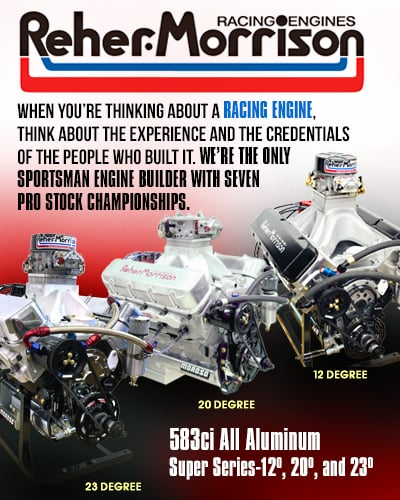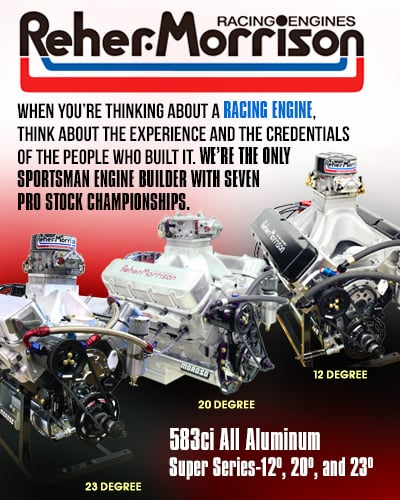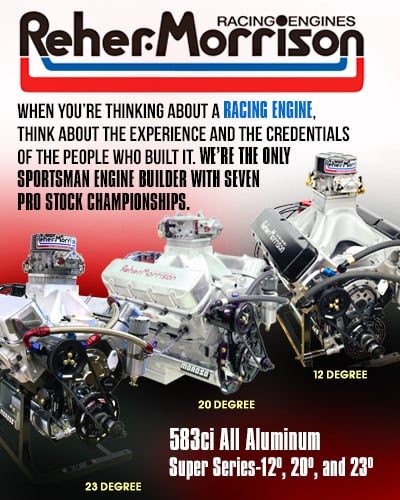PRO MOD PIONEERS ODDY, HAHN REUNITE, RESUME WINNING WAYS
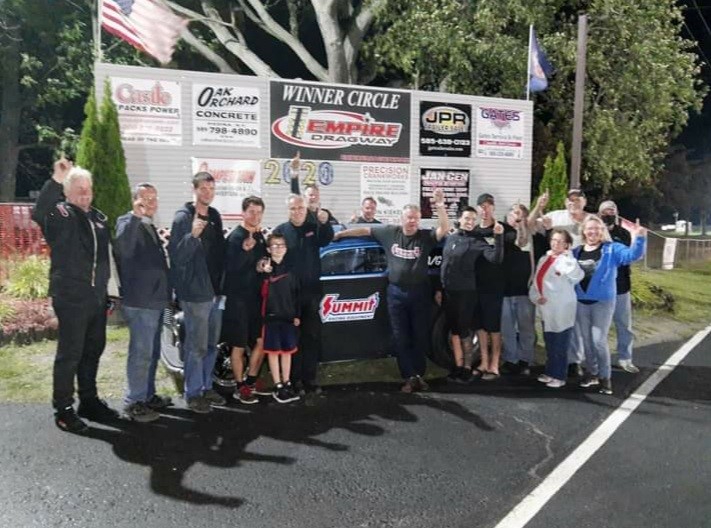
Bone-tired from crisscrossing the continent chasing Pro Modified wins and championships, Fred Hahn turned his back on drag racing in 2004. He had his Summit firesuit dry-cleaned, then hung it in a closet with other firesuits he never intended to wear again.
Not ever.
 And then, some 15 years later, the phone rang. Hahn instantly recognized the number. Initiating the call was Jim Oddy, the man who owned and tuned the cars Hahn drove to nearly two handfuls of Pro Modified titles. Oddy posed a question that caught Hahn off guard.
And then, some 15 years later, the phone rang. Hahn instantly recognized the number. Initiating the call was Jim Oddy, the man who owned and tuned the cars Hahn drove to nearly two handfuls of Pro Modified titles. Oddy posed a question that caught Hahn off guard.
“‘Hey, does your firesuit still fit?’ ” Hahn recalled. “I said, ‘I have no idea, it ain’t been out of the bag in probably 11 years. Why would you ask that kind of question?’ He says, ‘Because I need your help.’ ”
“I did not give him an answer that day. I said, ‘I really have to sleep on this for the night.’ After a lot of soul searching and deep thinking, I agreed to go help him out for one run. My wife, Karen, being as smart as she is, told me before I started, ‘This isn’t going to be the end of this.’
“‘Yeah, it will.’
“‘No, it won’t.’ ”
Oddy wanted Hahn to make a pass at Lancaster (N.Y.) Dragway to check his car’s condition after a run-in with the guardrail. Hahn’s involvement didn’t end with the lone attempt, of course, and he and Oddy have now spent more than a year reunited.
They’ve been competing on the Supercharged AA Gassers circuit that’s based in Buffalo, N.Y. After some difficulties getting the handbuilt ’48 Austin to handle properly, and for Hahn to figure out how to drive a clutchless car for the first time in his illustrious career, they won the final two events of the series’ 2020 season.
But Oddy first had to patiently wait for Hahn to make up his mind.
“He really kind of got away from it when we quit there,” said Oddy, whose accomplishments earned him induction in the International Drag Racing Hall of Fame in March 2019. “He wanted to take a break and not be involved. He knew if he hung out at the racetrack he would be back driving something.
“There were a lot of people who wanted him to drive Funny Cars and Altereds, a lot of people were chasing him," said Oddy. "But he just decided to stay away for a while and have some time with his wife and his kids. When we ran Pro Mod, sometimes we’d race 30 times a summer and still work 40-hour-a-week jobs.”
Their accomplishments as true Pro Mod pioneers were breathtaking: championships with the United States Super Circuit (1991-93), Super Chevy (1995-97), IHRA (2000), and NHRA (2003). Toss in a Canadian crown from a series at Cayuga, Ontario, and that’s nine titles in a decade.
Without Hahn driving his cars, racing just wasn’t the same for Oddy, who stepped away from the sport in 2006, two years after Hahn stowed his uniform. He kept his business, Oddy’s Automotive, running until ’09 when he turned it over to one of his employees. That was about the time he and his wife, Charlene -- “Grandma Char,” he calls her -- decided to escape the wicked winters near the junction of lakes Erie, Huron and Ontario and moved south to the Lake Norman area near Charlotte, N.C.
When they left Elma, N.Y., the Oddys also put 600-plus miles between themselves and 12 of their now-14 grandchildren. They made frequent trips home for important events such as birthdays and kindergarten graduations, Jim said; so often, in fact, that they decided to become “snowbirds.” They bought a “fixer-upper house out in the country” near Buffalo, Jim said, that is home in warmer months. When the temps begin to plummet, they head south to wait out the winter in North Carolina, where a son and two grandchildren reside.
One thing Jim Oddy is not, even in his retirement years and approaching his 78th birthday, is a couch potato. Back in his old stomping grounds in New York half the year, he naturally gravitated to the dragstrip, and the chance to face off against the competitors of the Supercharged AA Gassers tour proved to be an irresistible temptation.
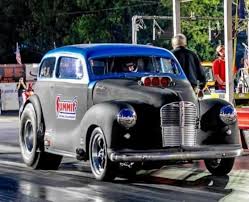 On Oddy’s request, a friend located a junker of a 1948 Austin -- a four-door model -- in a field outside of Buffalo. Oddy craved the Austin for the simplest of reasons: A ’48 was the first car on which he added a supercharger.
On Oddy’s request, a friend located a junker of a 1948 Austin -- a four-door model -- in a field outside of Buffalo. Oddy craved the Austin for the simplest of reasons: A ’48 was the first car on which he added a supercharger.
His original Austin was a two-door imported from its homeland in England, but those versions are virtually impossible to find seven decades later. The four-door in the field was better than nothing, and it offered Oddy the challenge that has always drawn him to racing; that is, making what seems impossible, possible. He sawed the car in half and began its conversion into a two-door meant for the dragstrip.
The Supercharged AA Gassers circuit has a special appeal to Oddy, being that it’s head’s-up racing with superchargers “and it’s affordable,” he said. The guidelines for the circuit consist of “a little rule page or so,” he said, and require cast-iron motors, a Vertex mag and a stock supercharger. All of the events are contested in the eighth-mile.
“Pretty much everything on the car has to be what was available in the ’60s,” Oddy said. “When I was 20-some years old, I was lucky enough to run around the country with K.S. Pittman, Stone, Woods and Cook, and Junior Thompson. That was where I started, AA/Gas. Before Funny Car came along, they were it. We raced three times a weekend -- every weekend, all summer -- with those guys. That’s where I started this whole deal.”
The camaraderie among the competitors is another big drawing card. It’s “a coupla days of partying and about 20 seconds of racing,” said Oddy, who won the 1972 U.S. Nationals as a Competition Eliminator driver.
“We’re all kind of up there in age, and we don’t want to work really hard on these cars,” he said. “It’s a head’s-up start, and the winner at the end is the winner -- just like it was in the ’60s.”
Oddy added that his greatest fulfillment comes from tracking down the old parts needed to build and maintain the car.
“I have more fun building the cars than I actually do racing them. It’s just something that keeps me busy every day,” he said. “I love to cut and grind and weld and build motors and build blowers. It’s just what I still enjoy doing. When I have those days that I feel good, I’m out in the garage beating on something.”
Another thing that hasn’t changed is Oddy’s competitive fire. There’s a time for fun, and then there’s the point of being there, which is to beat everybody else.
“Jim’s a very aggressive tuner. He’s out there to win,” Hahn said. “As much as he’s doing it for fun, even in this class here and being with the guys, Jim still leaves home to win. He just don’t go out there to not qualify or get fourth place or whatever.”
That’s what made the early going with the Supercharged AA Gassers tough on Oddy, who said it “took two years before we won our first round.”
Surprisingly, Oddy struggled out of the gate to coax consistent performance out of the Austin -- but he didn’t have Hahn in the driver’s seat at that point, either. And even when Hahn agreed to a reunion, they had a tough time making the car behave.
“Once we decided to spend our summers up in Buffalo, obviously there’s only one driver that I would love to have drive the car and that was Fred,” Oddy said. “I kind of drug him back into the car kickin’ and screamin’, but I got him in there.”
“Fred’s one of the best seat-of-the-pants drivers I’ve ever come across no matter what he sat in. But even with feedback from Fred, it took about 50 runs before we got this thing to go down the racetrack.”
He admitted, with a chuckle, that he was part of the problem with the car’s early outings.
“It was mostly self-inflicted wounds. I can’t leave nothing alone,” Oddy said. “We were trying to reinvent the wheel and we finally got it. It’s pretty good right now. It’s not great, but a lot of the stuff we struggled with was worth the struggle for what we now have.”
The biggest change came after Hahn climbed in the Austin and began dishing out the feedback Oddy needed. First, though, the 68-year-old Hahn had to figure out how to drive a racecar that didn’t have a clutch pedal. The transmission in the Austin is an automatic; the transition for Hahn was anything but.
“We went out to Empire (Dragway in Leicester, N.Y.), made a pass, and I about put the thing through the guardrails on the roof,” Hahn said. “The pass was fine -- no trouble with the pass -- it’s that clutch pedal that ain’t there at the other end. Everything is a reaction to an action, so when you go through the traps at the other end, the first thing I’ve done all my life is clutch the car -- but now the clutch pedal is the brake pedal. That’s not a healthy situation.”
 Oddy remembers multiple times in which he thought Hahn was the blink of an eye from destroying his cars, including the Austin.
Oddy remembers multiple times in which he thought Hahn was the blink of an eye from destroying his cars, including the Austin.
“If you could see how sideways he’d have one of these cars and get it back straight without hitting nothing, you would be amazed,” Oddy said. “Sometimes I’d just turn around and walk away and go, ‘Well, I hope Fred’s alright because I’ve got to start on a new car.’ Everybody’d be, ‘Whoa!’ I’d look over, the cloud of smoke would clear, and there’s Fred, sitting on the return road, getting out of the car. I don’t know how in the hell he did that.
“With this car, once we got it down the racetrack and got it right we were good to go. Holy moly. Fred kills these guys on the lights.”
“I was terrible in it,” Hahn said. “This is just a stab-and-steer deal. You leave it on idle and just stab the throttle; there’s no line locks or none of that stuff. This thing would move and knock the tires off the car, knock the fillings out of my teeth. … I had signs pasted on the rollbars ‘NO CLUTCH IN THIS CAR.’
“You don’t think about what you do in a racecar in a heartbeat, you just react to the action. So when the thing goes out and knocks the tires off, the first thing I want to do is push the clutch to uncouple the motor from the drivetrain. Here, there are only two pedals. On the right-hand side is the throttle pedal; on the left-hand side is the brake. My whole life, every car I’ve ever been in has had a clutch pedal. And hand brakes almost my whole career. …
“After about eight weeks of this, I told Jim, ‘You need to put somebody else in the car -- somebody who’s used to a Powerglide and can drive the car the way it needs to be driven.’ He said, ‘Nah, I don’t want to do that. You’ll get it.’ So he was very, very patient. I’d have fired my ass long before that. He was very patient, and we come down to now to where, if I do say, we’re pretty good. My lights are better than anybody’s out there, and we’ve got a car that goes from A to B and runs 4.90 pretty effortlessly -- but it took a long, long, long time to get it there.”
The car began performing in late summer the way Oddy and Hahn wanted all along, to the point that they won the final two races of the season at Empire and Lebanon Valley.
“Once we got this thing going down the racetrack more than one time in a row, it’s just, ‘Holy moly, wow, look at this!’ It’s still amazing,” Oddy said. “Fred just gets in there and he’s got control of the situation.
“Empire, he won the race and bounced off the wall. He went 4.89, 142, or something, and it ended up getting pretty dark. Fred said, ‘I’ve got old eyes, they don’t do so good anymore, and I got out of the groove to the left side and kinda yanked it back.’ It’s night, so there’s a shower of sparks and they’re sending the wrecker down there and all that. I told them, ‘Believe me, it’ll be fine. Fred will be fine, it’s not a big deal.’ The next weekend, we raced at Lebanon Valley and won that one.”
Providing some fireworks isn’t Hahn trying to put on a show, it’s a facet of his M.O. as a driver. In that respect, the time away from racing didn’t change him one iota.
“When I’m in that car,” Hahn said, “I’m very aggressive. You drive this thing until it’s on fire or on the roof. You don’t just let off because it’s a little out of the groove. If you did that every time, you’d never win a race.”
The key to their continued success, Oddy said, is the same thing it’s always been: Devotion to a nugget of wisdom his father, Don, conveyed more than 60 years ago.
“You either get down to the work or you don’t do the work,” Jim said. “My dad died when I was in high school. He was a fabricator, helped me get going, and he worked on my first racecar. The biggest thing he told me was, ‘With your two hands, if you want to do the work, there’s nothing that you can’t do.’
“That’s kind of where it all started, and the good Lord still lets me go out there and do the work with my two hands. I still enjoy doing the work.”
https://t.co/fwcYLHeq2o is now taking orders for the newest face-covering expected to ship within two weeks. Get yours today before they are gone, as they sell out quickly. - https://t.co/qQ3i8duUGw pic.twitter.com/N1jDKckW0f
— Competition Plus (@competitionplus) November 14, 2020
























